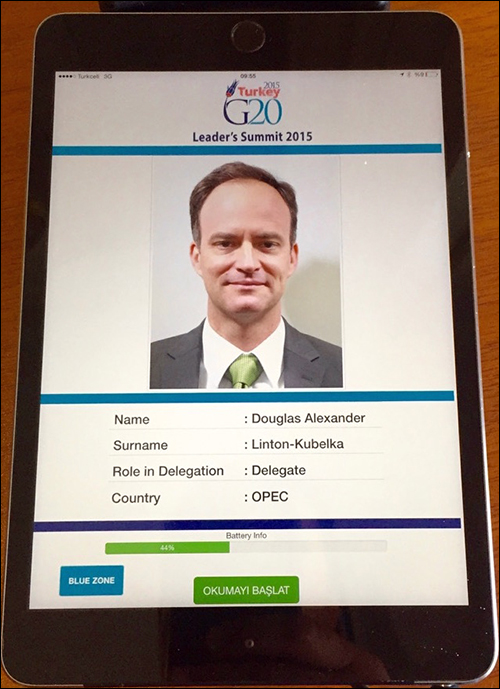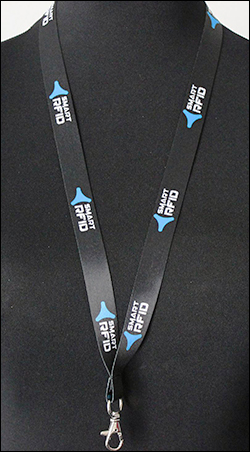Here is the lineup of noteworthy announcements made during the past week about the following organizations and products:
TexTrace, Eximia;
Turck, U Grok It;
Smart Technology Group;
RFIDcoder; and
SML Group.
TexTrace, Eximia Partner on Mobile Solution for Fashion Brand Protection
TexTrace has partnered with RFID systems integrator Eximia to develop a mobile brand protection solution powered by radio frequency identification technology. The eBrand solution, the two companies report, is designed to help fashion brands securely verify the authenticity of their products throughout the worldwide supply chain, thereby protecting their customers and their reputation from counterfeits and gray markets.
The end-to-end product-authentication solution, the companies indicate, blends TexTrace’s expertise in the design and manufacture of woven RFID brand labels with sophisticated algorithms and mobile systems integration know-how from Eximia. eBrand features three key components: an RFID label, an app and an authentication server. The TexTrace Woven RFID Brand Label is a fabric label with a built-in EPC Gen 2 passive ultrahigh-frequency (UHF) RFID chip, a protective pad and a stitched-in antenna consisting of what the company calls electronically sensitive yarn (see Luxury Apparel Maker to Test TexTrace’s Fabric RFID Label). The woven RFID label is encoded by the eBrand platform with a proprietary algorithm that combines a tag identifier (TID) code, an Electronic Product Code (EPC) and additional information as requested by the client. Each RFID label’s data is stored in the eBrand Authentication Server Database, where it is linked to product such information as origin, location, style and collection.
The eBrand mobile apps for Android and iOS phones are delivered to the specific brand customer, and can read RFID label data through built-in smartphone RFID readers or an interrogator connected to the phone via a Bluetooth connection. The apps communicate with the authentication server in order to run the verification process by sending the RFID label data to the server, which verifies the product’s authenticity and credentials, returning a “valid” or “invalid” message to the eBrand app. For products deemed invalid, the companies note, the eBrand app issues an alert to the inspector and stores the inspection data on the server platform.
Turck Offers Smartphone App, U Grok It Handheld Reader to Industrial Customers
Turck and U Grok It have announced a long-term, strategic partnership to bring U Grok It’s smartphone ultrahigh-frequency (UHF) RFID reader system into Turck’s RFID portfolio. The agreement allows Turck to provide its customers with U Grok It’s RFID readers and custom Turck RFID apps for their iOS, Android and Microsoft Windows mobile devices, which can be used in conjunction with Turck’s BL ident RFID system.
Turck’s BL ident portfolio consists of RFID tags, software, IP67-rated readers and, now, the new smartphone reader. BL ident was created to offer a solution for industrial RFID applications while retaining the flexibility of standard I/O solutions, Turck reports. According to the company, the portfolio lets customers order RFID in the same packages they are used to—as slices for modular I/O or channels for block I/O—and supports all major networking protocols. U Grok It’s reader is a battery-powered RFID reader, compliant with the EPC Gen 2 standard, that plugs into the audio port of a smartphone or tablet. The company also offers a software development kit (SDK), intended for developers to use in creating use case-specific apps (see U Grok It Releases UHF RFID Reader for Phones, Tablets).
“With our partnership, Turck expands its BL ident line to include smartphone UHF RFID readers, expanding their industrial automation capabilities with U Grok It’s ease of use and affordability so that tracking and tracing extends beyond the assembly line and throughout the organization and ecosystem,” said Carrie Requist, U Grok It’s cofounder and CEO, in a prepared statement. “We anticipate a long and successful relationship between Turck and U Grok It.”
Randy Durick, Turck’s VP of fieldbus technology, added in the statement that with the U Grok It reader, “This partnership allows Turck to provide an adaptable, economical UHF handheld solution for our customers and we look forward to our long-term partnership with U Grok It.”
The new solution is expected to be made available during the upcoming weeks.
Smart Technology Group Announces UHF RFID Lanyard
Smart Technology Group (STG), a Swiss and Polish technology firm, has announced a new EPC Gen 2 RFID tag in the form of a lanyard designed especially for access-control and time-attendance systems.
Incorporated into the company’s new ST Lanyard is a complete ultrahigh-frequency (UHF) inlay, made with an Alien Technology Higgs 3 chip. The lanyard has already been successfully tested during the tag’s first implementation at the Exploseum Military Technology Center, a museum at a Polish World War II-era explosives factory. Tourists visiting the museum wear the lanyards so that employees can precisely track their locations (see RFID Ignites Interest in Nazi Explosives Museum).
“Our idea is the result of searching for an answer, how to provide the smoothest possible flow of employees between zones, areas and halls,” said, Grzegorz Jedrzejczyk, a Smart Technology Group engineer, in a prepared statement. “We aimed at elimination of necessity of showing identification cards and putting them to reader. We really cared about facilitating the entire process. Our final goal was to allow people to be identified without having to do any action.”
Individuals wearing the lanyard need only walk beneath a reader antenna, or between RFID security gates, to be automatically and immediately identified, the company explains. In addition, the lanyard can be used to grant a person access to a particular zone. The ST Lanyard is designed to alleviate problems associated with traditional identification cards, which can be hidden under clothing or obscured due to a wearer’s height—even an identification card carried on a lanyard, STG notes, may accidentally become hidden under clothing. The ST Lanyard, which almost always hangs around a wearer’s neck, will be read on every occasion, the company says, since the RFID tag is not located in one particular place in the lanyard—its entire surface is one tag.
The ST Lanyard has been designed to work in conjunction with circular-polarization antennas. It can be customized to meet a customer’s specific requirements, and can include a company’s logo, name or other visual identification. Its weight is the same as that of a typical lanyard, the company adds.
“In Smart Technology Group we are constantly looking for new, intelligent ways to solve challenges which our clients face,” Karolina Kozlowska, STG’s CEO, added in the statement. “ST Lanyard meets expectations of people managing the access control and real time locating system. It allows them to effectively – and cheaply – manage with employees flow or to track people’s location, e.g., during big-scale events.”
Low-Cost RFIDcoder Cloud-Based Service Aims to Simplify Tag Encoding, Decoding
Ken Traub Consulting LLC, a Boston firm that provides services to software product companies and to enterprises and that specializes in RFID technologies, has announced the launch of RFIDcoder, the company’s cloud-based service for encoding and decoding ultrahigh-frequency (UHF) Gen 2 RFID tags according to GS1‘s EPC Tag Data Standard.
RFID tags used in apparel, aerospace, health care and consumer products are
most often encoded according to the GS1 EPC Tag Data Standard, according to Ken Traub, the company’s founder. As an example of common tag encoding, an apparel item is represented by a Serialized Global Trade Item Number (SGTIN) consisting of the product’s Universal Product Code (UPC), associated with its Global Trade Identification Number (GTIN), as well as a unique serial number. But these data elements are encoded into the tag in a particular way, Traub explains, so any software that needs to read the tag, or used by the manufacturer to encode the tag, needs to be able to convert between the GTIN and serial number and the form encoded in the RFID chip’s memory.
Developers of such software have had to either figure out the complex encoding and decoding rules themselves, Traub says, or else license a specialized encoding-decoding software library for use within their own software product. Traub’s company licenses such a library, he says, but the cost has not always been within reach for developers, especially those writing non-commercial software or just starting out.
The new RFIDcoder service is designed to fill that gap, Traub says. RFIDcoder is a cloud-based service delivered as an application programming interface (API), employing a representational state transfer (REST) architecture using the popular JSON syntax, which integrates easily into all types of software applications. Using RFIDcoder eliminates the need to license an encoding-decoding software library, or to figure out how to integrate it into an application. Instead, he adds, a developer signs up for an RFIDcoder account, then encodes or decodes tag data by making a simple Web services call to RFIDcoder. A developer can encode and decode tags within minutes of signing up for an account, Traub says.
In addition, RFIDcoder automatically determines the length of a company’s GS1 prefix when encoding tags, using data that GS1 began publishing just last week. Previously, this was an extra step that complicated the process of encoding tags, particularly for third-party labelers who encode tags for many different manufacturers.
The cost of the RFIDcoder service is based on the volume of encoding and decoding operations performed. For developers who need no more than 100 operations per day, Traub says, it is free. Those who need to create a self-contained solution not requiring Internet access can still license Ken Traub Consulting’s encoding-decoding software library.
SML Group Releases Smaller RFID Inlay With Monza R6 Chip for Retail
SML Group has announced its GB4R6 inlay, a smaller inlay that is part of the company’s family of inlays featuring Impinj‘s Monza R6 chip. The GB4R6’s diminutive size—1.84 inches by 0.63 inch (45 millimeters by16 millimeters)—makes it suitable for lingerie and other apparel requiring labels with a small footprint, the company reports.
The GB4R6 offers privacy protection with on/off RF toggle capability, the company says, and leverages Impinj’s AutoTune technology to deliver more consistent read performance. SML’s network of worldwide service bureaus can deliver imprinted, encoded RFID stickers, hangtags and fabric care labels to custom specifications, when and where needed.
The GB4R6 is already in use in pilot deployments, according to SML Group. “SML’s comprehensive RFID product expertise, combined with the unique features and performance of the Impinj Monza R6 chip, delivers new functionality to retail inventory management,” said Craig Cotton, Impinj’s VP of marketing and product management, in a prepared statement. “The SML GB4R6 inlay gives retailers a broad choice in the size and material of their RFID hang tags, making it suitable for all types of tickets and labels that will be attached to apparel garments.”



